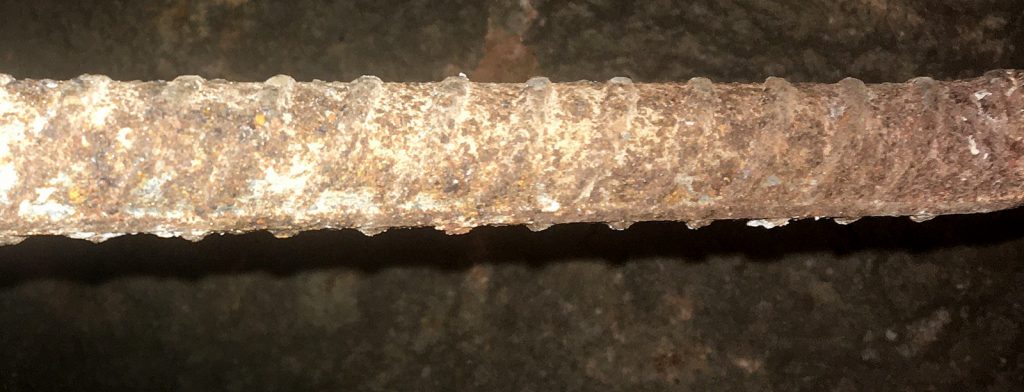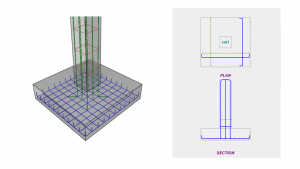Corrosion in the reinforcement is a leading reason for the concrete deterioration that every civil engineer should aware of. Steel is a thermally unstable material. It undergoes many energy absorption steps during the production process. Throughout the service life, mother nature takes back that energy turning the steel back to its original constituents – rust!

Corrosion is simply the natural way of metal destruction. It follows by chemical, electrochemical, and electrolytic reactions. To get corrosion you need 4 things. A metal, oxygen, some kind of way to transfer electrons and water. In this chemical reaction, some parts of the steel act as an Anode. It loses electrons; On the other hand, another part of the steel acts as a cathode. In here, oxygen combines with water and the electrons to release hydroxide ions.
When corrosion starts, it continues until one of the above requirements ran out. So, in most cases, corrosion continues until the complete decay of reinforcement. Iron rust is chemically known as ferrous oxide. The electrochemical reaction between steel and oxygen produce the rust.

4Fe + 3O2 + 6H2O → 4Fe(OH)3
The properties of rust are completely different from steel. It’s weak, not elastic, and more in volume than the original steel volume.
Effect on the concrete
Reinforced concrete is a composite material. The compressive stress is taken by the concrete mortar and the tensile stress is taken by steel reinforcement. Steel in the concrete is almost safe. The alkaline nature of the concrete produces a protective coating around the reinforcement. This is a thin but dense coating reducing corrosion potential by 1000 times. However, when the pH value reduces due to acidic chemicals, this coating decays. It starts the corrosion of the reinforcement. When the steel is corroded inside the concrete, tensile capacity is reduced. This can result in yielding reinforcement well before the design loads.
Corrosion is not only defective to rebars. It also deteriorates the concrete too. In fact, it is one of the number one parameter consider in structural auditing. Initially, it generates brown stains tracing the reinforcement. Then the rust absorbs the water it tries to swell. In the end, these swelling rebars develop cracks in the concrete even breaking into pieces.
There are two possible attacks on the reinforcement inside the concrete.
Carbonation
Carbonation occurs when calcium hydroxide in the concrete reacts with carbon dioxide (CO2) from the atmosphere and water (H2O) in the concrete pores. This is a slow process compared to the salt attack. Consumption of calcium hydroxide reduces the alkalinity in the concrete. it makes the protective coating unstable. Reducing the pH value below 10 helps to start the corrosion.
Salt attack
Salts are mildly acidic and common soluble in the groundwater. They lower the ph value in the concrete. Chlorides and iodides can dissolve in the water and penetrate easily into the concrete. also, the de-icing salts using on the pavements will mix with the groundwater. Absorbing salt into the concrete can decay the protective coating around the reinforcement. The threshold concentration for chloride irons is 0.2% to 0.4% by weight of cement.
Concrete having high permeability and high water to cement ratio is highly vulnerable to carbonation and salt attacks. Giving good compaction as well as maintaining enough cover is a must when facing these. One of the effective solutions for rebar corrosion is the use of high alloy steel as reinforcement. But this costs nearly 10 times the conventional reinforcement bars. Therefore, frequent monitoring and maintaining methods are still a popular and realistic solution.
How to detect reinforcement corrosion inside concrete
When rebars are corroding inside the concrete, it’s hard to identify at the beginning. At some point, we can observe calcium chlorides and brown color stains on the concrete. after this stage concrete will crack due to swelling of rust. Unfortunately, at the time when these symptoms appear, most of the rebar is already corroded. Therefore prior assessment of the rebar corrosion has improved the durability in many ways.
- Possibility of early warning and control
- Less maintenance and operational cost
- Reduce construction and installation costs
- Improve the lifetime of offshore structures
The number one way of assessing the reinforcement corrosion is through sampling. But this is a destructive method. Frequent monitoring can be harmful to the structure. There are several non-destructive ways in the field to assess reinforcement corrosion.
One of the nondestructive test methods to detect corrosion of the reinforcing bars is acoustic methods. It refers to detecting the energy waves produced by a sudden redistribution of stress in material under loading. The behavior of the waves through the structure reflects the internal flaws, voids, and cracks
Half-cell potential method
this method uses the measurements of surface potential to detect corrosion. Half-cell potential values refer to copper sulfate electrode is used to measure the corrosion potential. You can develop a map showing the corrosion potential using the data. 3 different Half-cell potential ranges appear in ASTM 876.
Half-cell potential values less than -350 mV represent the probability of having active corrosion is more than 90%.
When the measurement is greater than -200 mV, this probability is less than 10%. Results for half-cell potential values between -200 mV to -350 mV is uncertain.
The AC impedance method,
AC impedance technique is a very powerful technique in corrosion study. It uses an AC to study the electrical response of a corroding bar in concrete. A small AC potential is applied to the rebar, and the current response is analyzed. Then determine the impedance of the system. The method is difficult to use as a field technician but can be a very useful technique in laboratory investigation.
Summery
Rebar rusting is one of the leading concern in the durability of concrete structures. Unfortunately, reinforced concrete got all the required compounds in it to start the corrosion. Alkaline nature in the concrete helps to halt the corrosion reaction by building a passive layer around the reinforcement. However, the carbonation and saltwater penetrate this passive protective layer and deteriorate the reinforcement.
Reinforcement corrosion is not a thing that we can stop 100%. Therefore prior assessment and good maintenance are essential for the durability of the structure. Several non-destructive methods are available in the field to detect corrosion as well as corrosion rate.


